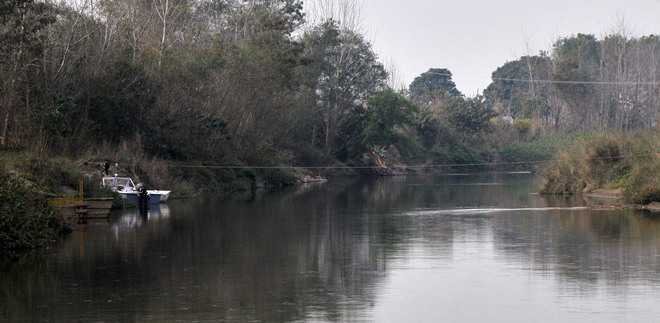Vijay Mohan,Tribune News Service.Pathankot, January 6

Though a large portion of the international border (IB) with Pakistan in Punjab remains vulnerable, a 30-km stretch opposite the Pathankot-Kathua axis remains the Achilles’ heel, being prone to cross-border smuggling and infiltration.Sources in the security establishment said the border stretch from Bamial village, near Pathankot, and Bobiya village, near Hiranagar in adjoining Kathua district of Jammu and Kashmir, has been a traditional ingress route because of riverine terrain and dense vegetation. This area is also known as Shakargarh bulge.Rivulets and tributaries of the Ravi, which meander along the IB in this sector, and the abundant growth of elephant grass in the area provide good cover in the dark. Though the border is fenced and lit by floodlights, there are places where it cannot be fenced and in some areas the fence gets damaged repeatedly due to the flow of water and soil erosion.A visit to a site along the Tarana rivulet, near Bamial village, a point where it enters India from Pakistan and winds down south before flowing across again, revealed heavy vegetation on either side of the stream, with poor visibility. Villagers said the water level in the river has increased a lot, thus affecting the embankments. The undulating terrain near the rivulet was in sharp contrast to the fields along the fence, where one can have a clear view over a long distance.Apart from the terrain, the stretch is close to the National Highway No. 1-A that links Jammu and Kashmir to the rest of India, providing infiltrators an easy access to move further. Given the orientation of the highway, infiltration from the Bamial area also gives them the choice of proceeding towards Jammu or Pathankot, sources said.Terrorists involved in the Gurdaspur incident in July, attack on an Army installation in Samba in March and the Pathankot air base this week are believed to have infiltrated into India via this stretch. The labyrinth of link roads connecting hamlets to the mainline are very confusing and for a first-time visitor, it is impossible to find his way without a guide.The Border Security Force (BSF) mans the border, with the Army deployed in the second tier in the area. Army men are also needed to patrol the area for familiarisation and training. Sources said the Army had raised the issue of the vulnerability of this stretch several times and also asked the BSF for additional deployment. The issue was also a point of discussion during a recent operational conference last month.A post mid-night drive through the area gave the impression of scattered settlements resembling ghost villages with virtually no sign of life. Other than some trucks, presumably ferrying sand and gravel through narrow, potholed link roads, no vehicles were seen.A number of nakas or check-posts manned by the police and the Central Reserve Police Force have come up along the highway as well as some interior roads. Though the security in the area has been stepped up following the air base incident, locals feel it is only a matter of time before the check-posts vanish and the usual slack approach takes over.
Easy route for terrorists
- The border stretch from Bamial village (near Pathankot) and Bobiya village (in Kathua district of Jammu and Kashmir) has been a traditional ingress route forterrorists
- This is because rivulets and tributaries of the Ravi, which meander along the IB in this sector, and abundant growth of elephant grass provide good cover to them
- Terrorists involved in the Gurdaspur incident, attack on an Army installation at Samba and the Pathankot air base are believed to have infiltrated through this area
